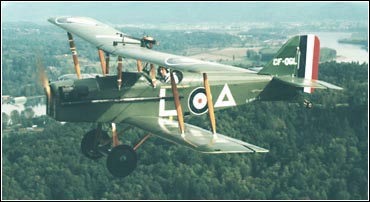
World War Plane Pictures
All the First World War aircraft, whether they are replicas or
originals, require great skill to fly and display. Because of their marginal power
and the difficulty in controlling the aircraft on take off and landing in anything
but the lightest of crosswinds, it is possible that these aircraft may not be seen flying, due to the
prevailing winds.
Displayed in “dog fight” routines, these aircraft give airshow spectators a feel of
the speed and appearance of these delicate and manoeuvrable, but deadly fighters.
*******************************************************************************************

SE5
This was one of Britain’s most successful fighters, or more properly, “Scouts”
(SE = Scout Experimental) as they
were known at that time. Entering Royal Flying Corps service in 1916 (the RFC was the
predecessor of the RAF
which was formed in 1918), it scored notable successes in the hands of pilots such as Albert Ball,
James McCudden and Edward Mannock (73 victories). Armament consisted of one fixed
Vickers gun, firing through the propeller arc, and a moveable Lewis gun, mounted on
the top wing, the latter proving most effective for making
unseen attacks on aircraft from below. Powered by an Hispano Suiza or Wolseley in-line engine, it
could reach speeds of up to 138 mph and a maximum altitude of 30,000 feet.The aircraft displayed
is actually a 5/8th scale replica, powered by a modern engine. Despite this pretence,
the aircraft has a very similar performance and
“look” of the original. Very few genuine SE5s have survived, but one belonging to the
Shuttleworth Trust can be seen flying regularly at Old Warden airfield in Bedfordshire.
*******************************************************************************************
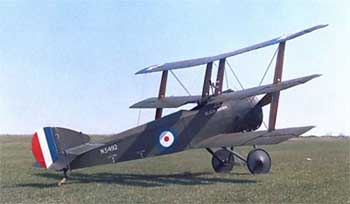
SOPWITH TRIPLANE
Sopwith Aircraft produced many famous aircraft, the Snipe, Dolphin and perhaps the most famous of all, the Camel.The Triplane was developed from the biplane Sopwith Pup, possessing greater manoeuvrability and climb rate than its predecessor.Sometimes known to pilots as the “Tripehound”, these aircraft entered service in 1916 with the Royal Naval Air Service (RNAS, predecessor of the Fleet Air Arm). In the hands of Naval pilots such as Raymond Collishaw, this aircraft scored notable victories against its German opponents of the time. It was so successful that it was widely believed its design was copied by the Germans leading to the design of the Fokker triplane. Powered by either a 110hp, or later, a 130 hp Clerget rotary engine, the aircraft could reach a maximum speed of 113 mph at heights up to and exceeding 25,000 feet. Armament was either one or two Vickers machine guns fitted on the upper fuselage decking, firing through the propeller arc.
*******************************************************************************************
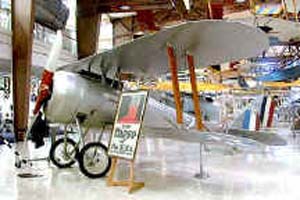
NIEUPORT 28
The Nieuport range of fighters was one of France’s most successful designs. The type 28, as shown here, entered service in 1917. These aircraft gained fame as the mount of American Expeditionary Force (AEF) airmen in 1917 / 18.Powered by a Gnome Monosoupape (single valve) rotary engine, it was capable of a maximum speed of 122 mph. Armament consisted of twin Vickers machine guns firing through the propeller arc.
*******************************************************************************************
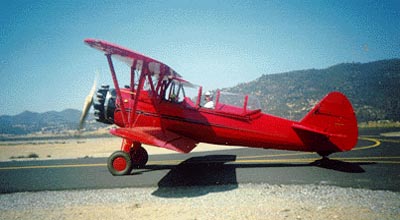
BOEING STEARMAN
The Stearman biplane, or PT-13 Kaydet, was designed as a primary trainer for the US Army Air Corps (forerunner of the US Army Air Force) and US Marine Corps.In this role, it served with distinction, over 12,000 being produced by the end of World War II. The aircraft was used to train many thousands of American pilots, and several thousand UK and Allied pilots, the latter sent from the UK to America to receive basic and advanced flying training.In post war years, it has been used as a crop sprayer, water bomber, occasional film star, and most familiar to air show audiences, as an aerobatic aircraft, often used to recreate the barnstorming days of the 1930’s.In the UK, a pair of Stearmans are used by the popular “Utterly Butterly” wing walking and aerobatic display team.Powered by a variety of Wright radial engines ranging from 250 to nearly 500hp, the Stearman is amply provided with sufficient power to produce spectacular aerobatic displays. Even so, one Stearman has been modified by it’s American owner/pilot to accommodate a turbojet mounted beneath the fuselage. The resultant rate of climb (in excess of 7,000 feet per minute) has to be seen to be believed!
*******************************************************************************************

HAWKER HURRICANE
This aircraft was a monoplane development of the Hawker family of biplane single seat fighters. Designed by a team under the leadership of the brilliant designer Sydney (later Sir) Camm, the Hurricane first flew in 1935, powered by a Rolls Royce 12 cylinder Merlin engine developing 1200 hp. Constructed of square section metal tubing, covered in fabric, the Hurricane was relatively easy to produce and repair using conventional techniques of the day.
Entering service in 1937, some 2300 Hurricanes equipped RAF squadrons in August 1940 at the time of the Battle of Britain, outnumbering its more glamorous stablemate, the Spitfire, by 2 to 1. The Hurricane bore the brunt of the fighting in the Battle of Britain, and proved to be a rugged, dependable fighter. Equipped with 8 machine guns (0.303” calibre) in the wings, the Hurricane served with distinction in the Arctic, Mediterranean, the Western Desert, the Far East and Russia. They were also adapted to serve aboard aircraft carriers, protecting convoys during perilous North Atlantic crossings.
Top speed was approximately 340 mph at approximately 28,000 feet. Nearly 15,000 Hurricanes were built in the UK and Canada.Some 8 or 9 Hurricanes are now in airworthy condition around the World, a significant increase since the 1980s, with some aircraft being recovered from Russia.
*******************************************************************************************
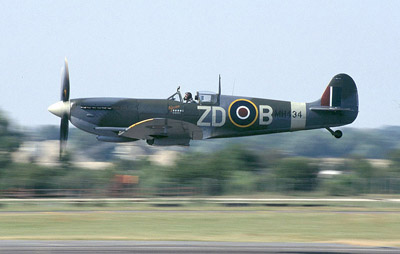
VICKERS SUPERMARINE SPITFIRE
This aircraft caught the public imagination in 1940, and still retains that position today. Designed by R. J. Mitchell, it combines a purity and beauty of line with uncompromising function, the Spitfire epitomised the “glamour” of the fighter pilot “Brylcreem Boys” of WWII days.Tracing its ancestry from the Schneider trophy racing float planes of the 1920s and 30s, the Spitfire (originally named the Shrew!) is a single seat monoplane having a monocoque structure (i.e. the skin of the aircraft formed around lightweight frames provides the strength). This was a relatively new method of construction in its day, and was a major advance over structures such as the Hurricane’s. But with this advance of light weight and high strength came the complexities of manufacturing such a structure. This led to production difficulties and consequent slow deliveries to squadrons in 1939 -1940.
The Spitfire first flew in 1936 and entered RAF service in 1938. Powered (like the Hurricane) by a Rolls Royce Merlin, and equipped with 8 machine guns in the wings, this combination proved to be a fighter pilot’s dream, the handling and manoeuvrability being outstanding.
The Spitfire was continuously developed during the War years, engine power being doubled and weight almost tripling by the time the final mark 47 was produced in 1946. The Spitfire served with the RAF until 1954.Like the Hurricane, the Spitfire served with distinction in all theatres of war, and was adapted to be a carrier borne fighter, a role for which it was not entirely suited, but nonetheless discharged with
honour.Maximumspeed varied from 370 to 450 mph, dependent on Mark.
Many Spitfires are now airworthy, giving airshow spectators the opportunity of seeing and hearing this beautiful but deadly aircraft aloft in its element, the sky.
*******************************************************************************************
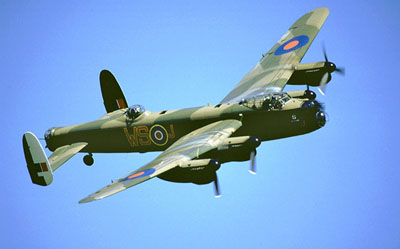
AVRO LANCASTER
The Lancaster was, in the words of Sir Arthur (“Bomber”) Harris, the “shining sword” in the hands of RAF Bomber Command aircrew between 1942 and 1945.Avro had responded to a requirement for a heavy night bomber by producing the Manchester, twin-engined aircraft. Unreliability of the Rolls Royce Vulture engines led to its withdrawal from service in 1941 / 42. Avro’s Chief designer, Roy Chadwick, redesigned the Manchester, fitting 4 Rolls Royce Merlin engines together with other structural changes to produce the Lancaster. Entering RAF Bomber Command service in 1942, the aircraft was an immediate success in its role as a heavy bomber, operating deep into Germany. Operated by a 7-man crew, it could routinely carry 10,000lb of bombs, eventually delivering the 22,000lb “Grand Slam” bomb designed by Barnes Wallis. It was another invention of this man’s prolific output, the “Bouncing Bomb” that brought the Lancaster to public attention in 1943 as a result of the famous “Dam Busters” raid.
This aircraft is one of only 2 airworthy Lancaster’s (the other is in Canada) and is part of the RAF Battle of Britain Memorial Flight (BBMF. Motto, “Lest we Forget”).Together with the BBMF Spitfire and Hurricane, they provide a fitting reminder of the sacrifice made by the men of the RAF during WWII, 56,000 of who lost their lives in Bomber Command alone.
*******************************************************************************************

THE RED ARROWS
The Red Arrows are the official RAF formation aerobatic team. Considered the best in the World, the Red Arrows have been in existence since the early 1960s, at that time flying the Folland (later Hawker Siddeley) Gnat 2 seat trainer, replaced by the BAe Hawk in 1980 (see later).
The team consists of 9 aircraft providing a 20-minute display of formation flying. The first half of the display involves all 9 aircraft, the team then splitting into two sections 5 and 4 each, and then finally 2 singleton aircraft are detached to perform opposition
manoeuvres. All pilots on the team serve for a period of 3 years, and all have a flying ability rated as “exceptional”.Of particular note during the display is the number of formation changes. This is a speciality of the Red Arrows, and is unequalled by any other national formation aerobatic team.The team make extensive use of smoke during their display. This effect is achieved by vapourising diesel fuel that is pumped into the hot jet exhaust. The “natural” colour is white. Mixing red or blue dye with the diesel fuel produces the red and blue
colours.The Red Arrows have been seen at air displays and events all over the World, demonstrating the skills and qualities of RAF pilots and engineers, but also assisting the exports of British manufacturers, particularly in the aerospace field.
*******************************************************************************************